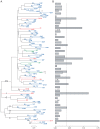Molecular epidemiology of HIV-1 transmission in a cohort of HIV-1 concordant heterosexual couples from Dakar, Senegal
- PMID: 22615999
- PMCID: PMC3355130
- DOI: 10.1371/journal.pone.0037402
Molecular epidemiology of HIV-1 transmission in a cohort of HIV-1 concordant heterosexual couples from Dakar, Senegal
Abstract
Background: A large number of HIV-1 infections in Africa occur in married couples. The predominant direction of intracouple transmission and the principal external origins of infection remain important issues of debate.
Methods: We investigated HIV-1 transmission in 46 HIV-1 concordant positive couples from Dakar, Senegal. Intracouple transmission was confirmed by maximum-likelihood phylogenetic analysis and pairwise distance comparisons of HIV-1 env gp41 sequences from both partners. Standardized interview data were used to deduce the direction as well as the external sources of the intracouple transmissions.
Results: Conservative molecular analyses showed linked viruses in 34 (74%) couples, unlinked viruses in 6 (13%) couples, and indeterminate results for 6 (13%) couples. The interview data corresponded completely with the molecular analyses: all linked couples reported internal transmission and all unlinked couples reported external sources of infection. The majority of linked couples (93%) reported the husband as internal source of infection. These husbands most frequently (82%) reported an occasional sexual relationship as external source of infection. Pairwise comparisons of the CD4 count, antiretroviral therapy status, and the proportion of gp41 ambiguous base pairs within transmission pairs correlated with the reported order of infection events.
Conclusions: In this suburban Senegalese population, a majority of HIV-1 concordant couples showed linked HIV-1 transmission with the husband as likely index partner. Our data emphasize the risk of married women for acquiring HIV-1 as a result of the occasional sexual relationships of their husbands.
Conflict of interest statement
Figures


References
-
- Piot P, Bartos M, Ghys PD, Walker N, Schwartlander B. The global impact of HIV/AIDS. Nature. 2001;410:968–973. - PubMed
-
- 2010 report on the global AIDS epidemic. 2010. The United Nations Joint Programme on HIV/AIDS (UNAIDS)
-
- Malamba SS, Mermin JH, Bunnell R, Mubangizi J, Kalule J, et al. Couples at risk: HIV-1 concordance and discordance among sexual partners receiving voluntary counseling and testing in Uganda. J Acquir Immune Defic Syndr. 2005;39:576–580. - PubMed
-
- Carael M, Van de Perre PH, Lepage PH, Allen S, Nsengumuremyi F, et al. Human immunodeficiency virus transmission among heterosexual couples in Central Africa. AIDS. 1988;2:201–205. - PubMed
-
- Carpenter LM, Kamali A, Ruberantwari A, Malamba SS, Whitworth JA. Rates of HIV-1 transmission within marriage in rural Uganda in relation to the HIV sero-status of the partners. AIDS. 1999;13:1083–1089. - PubMed
Publication types
MeSH terms
LinkOut - more resources
Full Text Sources
Medical
Molecular Biology Databases
Research Materials

